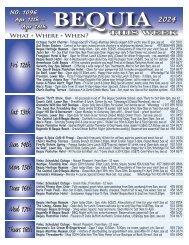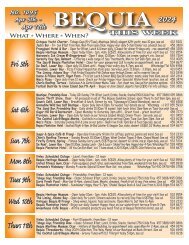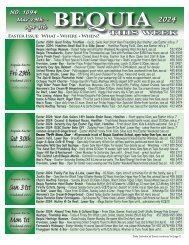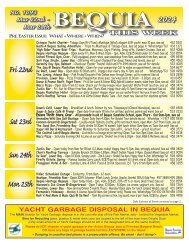Caribbean Compass Yachting Magazine - February 2021
Welcome to Caribbean Compass, the most widely-read boating publication in the Caribbean! THE MOST NEWS YOU CAN USE - feature articles on cruising destinations, regattas, environment, events...
Welcome to Caribbean Compass, the most widely-read boating publication in the Caribbean! THE MOST NEWS YOU CAN USE - feature articles on cruising destinations, regattas, environment, events...
You also want an ePaper? Increase the reach of your titles
YUMPU automatically turns print PDFs into web optimized ePapers that Google loves.
FEBRUARY <strong>2021</strong> CARIBBEAN COMPASS PAGE 30<br />
Finding My Depth<br />
by Jim Hutchinson<br />
The second half of my life began when I sold it all and bought a small yacht. It was<br />
about freedom, travel, adventure, whatever, but mostly it was about sailing. Then,<br />
in the Florida Keys and the Bahamas, I discovered snorkeling. Snorkeling, to my<br />
delight, proved half the fun of being out here.<br />
I got pretty good at it. Learning to clear my ears got me below the two-and-a-halfmetre<br />
barrier. Learning efficient moves, moving slow, and relaxing as my confidence<br />
grew gave me a working depth of eight metres (I could move or hand-set my anchor<br />
or tie a line to it at that depth). My personal record is 40 feet, 13 metres. I grabbed<br />
a handful of sand to prove it to myself, flipped over, and pushed off the bottom hard<br />
towards the sky, ascending with minimal flutter of fins. I was happy to reach the<br />
LOOK OUT FOR…<br />
A ‘PLUM’ OF MANY NAMES<br />
by Lynn Kaak<br />
The colors are most vivid in shallow water.<br />
As you travel through the <strong>Caribbean</strong>, every month there’s something special to look<br />
out for.<br />
Spondias purpurea goes by many monikers. Hog Plum seems pretty common, but<br />
in Grenada and parts of the Grenadines it is better known as Sugar Plum. In Bequia<br />
and St. Vincent it is Bequia Plum. Jocote is a fairly frequently used name in Spanishspeaking<br />
areas, but so is Mombin. Or Ciruela. In Trinidad it’s known as Jamaica<br />
Plum. Thankfully we can point when at a market, or just pick them off of the trees<br />
when they are in season (usually early summer, but varying by location), so the exact<br />
name isn’t always a necessity.<br />
The red Spondias purpurea is not to be confused with the yellow or orange Hot<br />
Plum, Chilli Plum, Yellow Mombin or Chinese Plum.<br />
Red Plum (an easy name to type) is native to Central America, calling the area from<br />
Southern Mexico down to Peru its birthplace. Once the Europeans discovered it, it<br />
was spread around the rest of the Tropics quickly and readily.<br />
While mangos are native to India and that part of the world, and these plums are<br />
from a whole other hemisphere, they are related. And they are both related to the<br />
cashew; yes, it sounds a little nuts, but that’s the scientific opinion. And like the<br />
mango, there are numerous varieties of Mombin to be found.<br />
The trees grow to about ten metres (35 feet) on average, but can be found as shrubs,<br />
or can tower to twice the average height, depending on elevation, age, soil and<br />
pruning. Typically, we will see them get to about seven metres (25 feet) in the Eastern<br />
<strong>Caribbean</strong> and closer to the coasts. The trunks are stout, while the branches are fairly<br />
thick, but not overly strong, with a tendency to being brittle so they can snap off fairly<br />
easily. The crowns of the trees open up, making them pleasant enough shade trees.<br />
As a deciduous tree, it will lose its leaves yearly. The leaves are 12 to 25 centimetres<br />
(four to ten inches) long, with a somewhat spear-like tip or arrowhead shape. There<br />
are slight “teeth” at the pointy end of the leaf, but it won’t bite. The young leaves are<br />
red or purplish, becoming dark green as they mature. The young leaves are eaten<br />
raw or cooked in some areas of Central America<br />
The small five-petalled flowers can be red or purple. They appear before the leaves<br />
reappear for the year. There are male, female, and bisexual flowers.<br />
The fruit are green as they develop and red or purplish when ripe. They are two to<br />
five centimetres long (one to two inches) with a glossy edible skin. The plums are<br />
roundish or oval, but there may be a small knob at one end, and they may have a<br />
little pitting on the skin. The ripe flesh is yellow and juicy, and surrounds a single<br />
pit or stone. They are best eaten when they have surpassed bright red and get little<br />
darker, as they will be at their sweetest then. Slightly under-ripe fruit are still edible,<br />
but may be a little more acidic, and certainly less sweet. Once ripe, the fruits come<br />
off the branches easily, so while a tree may seem laden one day, the next day it may<br />
all be lost to the ants if there has been a strong wind.<br />
CONNY HAGEN / ARAWAK DIVERS<br />
surface, but knew I could learn to go deeper.<br />
I don’t need to go deeper. On a good reef, I am fully entertained in one to four<br />
fathoms, where the light and the colors are at their best. That also covers my work<br />
and investigations in the anchorage (how I learned most of what I know about<br />
anchoring).<br />
In the Bahamas, where fishing with compressed air is prohibited, some snorkeling<br />
fishermen work as deep as 60 or 80 feet (25 metres). Bahamian fishermen build<br />
homes and raise families on their snorkeling skills.<br />
The December 2020 <strong>Compass</strong> has a lovely article by Lexi Fisher, “On a Single<br />
Breath of Air.” After my first read had settled in, I reckoned it worth a second read.<br />
Fisher dives deep as a sport — an extreme sport, she mentions the dangers. The<br />
photos in the article clearly show depth, a muting of colors and fading light. She<br />
speaks of how such diving is done, but some of the technique applies at any depth,<br />
notably, a relaxed mind and slow, deliberate movements.<br />
The Bahamians knew some of the tricks, but mostly learned on their own or from<br />
each other, gaining confidence (thus, relaxation), and knowing that it could be done.<br />
My halfway-to-their-depth snorkeling was pure recreation. The Bahamas, in<br />
particular, spoiled me. I typically anchored in two fathoms with good snorkeling within<br />
a few hundred metres. There was no end to what I could see in six metres of depth.<br />
I had been snorkeling for many years when nephew Doug, who is big on scuba,<br />
came to visit. I got scuba certified so we could dive together. Scuba is a good and<br />
popular way to explore underwater. I liked it a lot and even bought a second-hand<br />
scuba kit so I could dive from my own yacht. But I soon got rid of it. Paying a dive<br />
shop to rinse, dry and stow all of the gear was one thing, doing it aboard my little<br />
yacht with its frugal water supply was another. And tanks had to be taken to a dive<br />
shop for re-fills. Far more importantly, I agree with Fisher that not having a tank<br />
greatly improves the freedom. By this, I mean both freedom of movement and a<br />
delicious freedom of mind.<br />
If you’re on a small tropical island and don’t snorkel, to whatever depth, you’re<br />
missing half the fun… careful not to hit your head on the dinghy when you surface.<br />
#<br />
Bahamian fishermen knew how to do it, Fisher’s article tells us how it’s done. A<br />
couple of her points might be news to Bahamians, much was news to me — how it<br />
works more than what it does. It is interesting and often useful to know what lies<br />
beyond one’s horizon.<br />
Safety and security have become humanity’s big issues… after power, money and<br />
sex. Should you contact a “freediving center” and learn to go deep? Should you learn<br />
to snorkel moderate depths, such as I do? Should you simply lie on the surface with<br />
mask and snorkel, amazed at what can be seen even from there? Are you a swimmer,<br />
do you belong in the water? For that matter, do you belong on a yacht? Fisher’s<br />
article cautions us about the freediving that she advocates. My questions are also of<br />
caution — walking out the door is dangerous… as is staying at home. Let each of us<br />
make our own luck. But along those lines, Kurt Vonnegut advises, “Read the<br />
directions, even if you don’t follow them.” (Speech to MIT class of ’97.)<br />
Jim Hutchinson is the author of One Man’s Sampler, a collection of minor <strong>Caribbean</strong><br />
adventures. Hutch has been cruising aboard his 24- foot sloop, Ambia, since ’84,<br />
mostly in the <strong>Caribbean</strong>.<br />
In some areas of Central America, the ripe fruit is eaten with salt. The unripe fruit<br />
may be used to make preserves or to cook with. Mashing the ripe fruit and mixing<br />
the juice with water and sugar is also popular in some areas. Pickled plums with<br />
hot pepper may also be found in some places. Some people may have an allergic<br />
reaction if they are<br />
sensitive to poison ivy,<br />
poison oak, or mangos<br />
(yes, they are all related).<br />
Ripe plums are also<br />
popular “stewed” whole<br />
with water and sugar, and<br />
then bottled as a longlasting<br />
preserve.<br />
Red plums are definitely<br />
tropical, and don’t enjoy cold. They do better in areas with less rainfall, but don’t<br />
suffer too badly if planted in a wetter area as long as they get decent drainage. Full<br />
sun isn’t a concern for them, and the soil can be sandy, rich or pretty much any<br />
combination. A little bit of salt doesn’t seem to affect them, so being close to the coast<br />
isn’t a problem.<br />
The trees grow well from cuttings, which is far faster than trying to grow them from<br />
seeds. They are planted to act as natural fences in some areas, and with their<br />
unusual gnarled form are also popular for landscaping purposes.<br />
From a medicinal perspective, the juice of the leaves has been shown to have an<br />
antibacterial effect, and has been used for wound care by many peoples. Parts of the<br />
tree have also been used for intestinal problems, fever and infections.<br />
These trees can be found just about everywhere throughout the <strong>Caribbean</strong>. They<br />
are so common in some areas that you don’t always find the fruits for sale, as people<br />
can readily pick them for themselves and their friends.

















